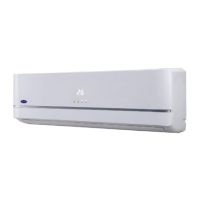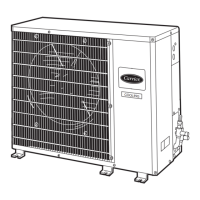7
compressor discharge service port, block
condenser coil, monitor pressure till compressor
trips, remove blockage and observe at which
pressure compressor restarts.
CAUTION
If the compressor does not trip at the cut-out
pressure (450 psig), remove the blockage
immediately and contact your local Carrier
service center.
Service Valves —The service valves in the
outdoor unit come from the factory frontseated.
This means the refrigerant charge is isolated
from the line-set connection ports. To prevent
damage to the valve, use a wet cloth or other
acceptable heat sink material on the valve before
brazing. The service valves must be backseated
(turned counterclockwise until seated) before the
service port caps can be removed and the hoses
of the gage manifold connected. In this position,
refrigerant has access from the through outdoor
and indoor unit. The service valve cannot be
field repaired; only a complete valve or valve
stem seal and service port caps are available for
replacement.
MAINTENANCE
WARNING
Before performing recommended maintenance,
be sureunit main power is off. Failure to do so
may result inelectrical shock or injury from
rotating fan blades.
Lubrication
COMPRESSOR—Compressor contains factory
oil charges; replace oil when lost. See Table 1
for oil recharge and refer to Carrier Standard
Service Techniques Manual, Chapter 1, pages 1
to 21 for oil recharging procedure.
Cleaning Coils — Coil should be washed
out with water or blown out with compressed
air. Note that the blowthru design causes dirt
and debris to build up on the inside of the coils.
Clean coil annually or as required by location
and outdoor air conditions. Inspect coil monthly
and clean as required. Fins are NOT continuous
through coil sections. Dirt and debris may pass
through the first section, become trapped
between the rows of fins, and restrict condenser
airflow. Use a flashlight to determine if dirt or
debris has collected between coil sections. Clean
coil as follows:
1. Turn off unit power.
2. Use a garden hose or other suitable equipment
to flush coil from the outside to remove dirt. Be
sure to flush all dirt and debris from drain holes
in the base of unit. Fan motors are waterproof.
WARNING
Do not use harsh chemicals to clean the coils,
use only water, compressed air or Carrier
approved coil cleaners.

